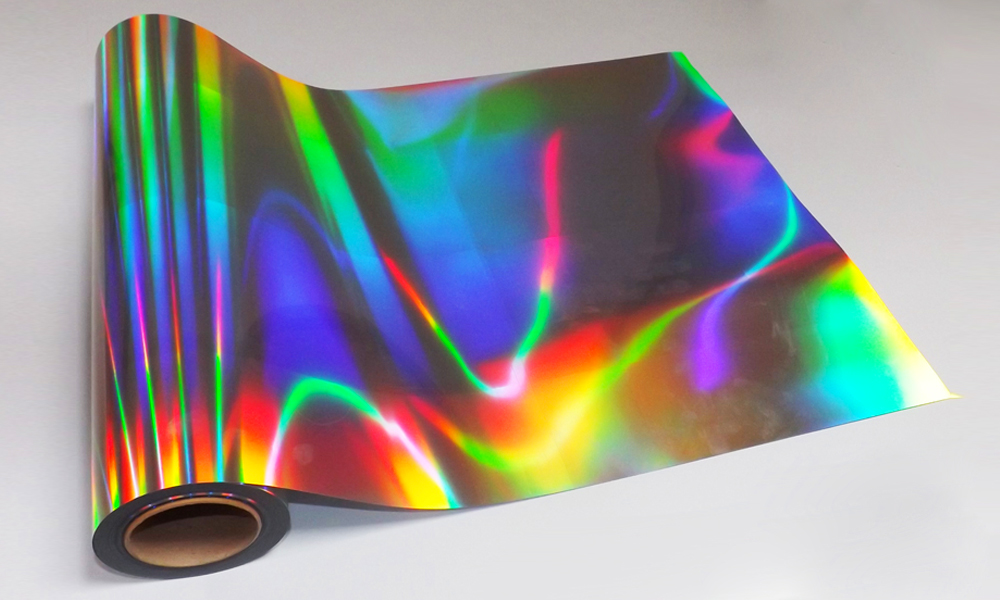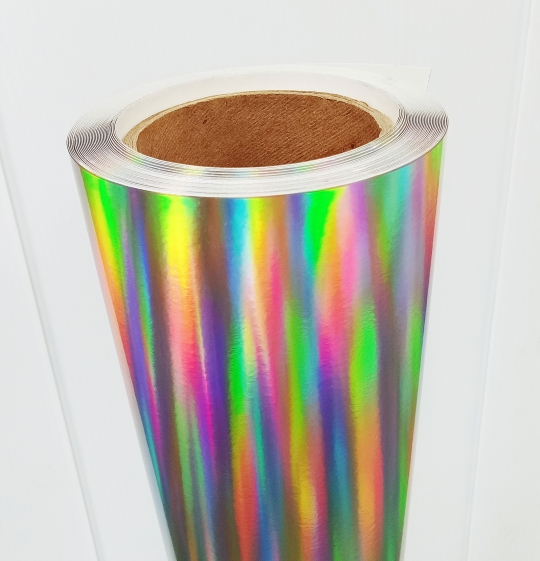Holo Film: Everything You Need to Know

Introduction to Holo Film
Holo film, also known as holographic film, is a type of thin plastic film that is patterned with microscopic grooves to diffract light into component colors, creating a beautiful iridescent rainbow effect. It is made from polyester (PET) and is widely used in various industries for its visually stunning and dimensional qualities.
What is holo film and how is it different from traditional films?
Holo film is different from traditional films in that it possesses a unique capacity to diffract light, creating a dimensional effect that traditional films cannot achieve. This distinct optical property of holo film makes it highly sought after in industries where visual appeal is essential.
Traditional films are often used for protection or preservation purposes, while holo film adds an extra layer of allure and intrigue to products, packaging, displays, and advertising materials. This makes holo film an excellent choice when aiming to make an impact and captivate viewers.
What are the common uses of holo film in different industries?
Holo film finds applications in a wide range of industries, including packaging, printing, advertising, and security. Here are some common uses of holo film:
- Packaging: Holo film is often used in brand-enhancing packaging, adding a luxurious and eye-catching element to product boxes, labels, and sleeves. It helps products stand out on store shelves and captivates consumers’ attention.
- Printing: Holo film can enhance the visual appeal of advertising materials such as brochures, catalogs, and posters. It adds a mesmerizing dimension to images and graphics, making them more captivating and memorable.
- Security: Holo film is commonly utilized for security and anti-counterfeiting measures. Its unique optical properties make it incredibly difficult to replicate, helping to protect products and documents from forgery. Holographic film plates are often used to create secure IDs, credit cards, and currency.
- Displays: Holo film is used in various displays, including trade show booths, signage, and retail window displays. Its stunning visual effects attract attention and create a memorable impression.
- Art and Craft: Holo film is a popular choice among artists and crafters for its ability to add a touch of magic to their creations. It can be used to make unique greeting cards, scrapbook layouts, and other crafts.
How is holo film manufactured and what are the key components?
Holo film is manufactured through a complex process that involves several steps. Here are the key components and manufacturing steps involved:
- Polyester (PET) Film: Holo film is made from a thin layer of polyester film, commonly known as PET. PET is a durable and flexible material that serves as the base for the holo film.
- Microscopic Grooves: The polyester film is then embossed with microscopic grooves using advanced technologies. These grooves diffract light, separating it into different colors and creating the mesmerizing iridescent effect.
- Metallization: To enhance the color and protect the film, it is often metallized with a thin layer of aluminum. This layer provides additional reflection and adds vibrancy to the colors produced by the diffracted light.
- Lamination: Holo film can be laminated onto various substrates like acrylics, polycarbonates, foam boards, vinyl, and more. This lamination process ensures that the holo film remains securely adhered to the chosen material.

In conclusion, holo film is a fascinating material that adds a captivating and dimensional quality to various products, packaging, and displays. Its unique optical properties make it an excellent choice for industries looking to enhance visual appeal and create a memorable impact. Whether used in packaging, printing, or security applications, holo film offers a range of benefits and opens up new possibilities for creativity and design.
Types and Applications of Holo Film

Holo film, also known as holographic film, is a specialized type of film that creates a visually stunning, multidimensional effect. This unique effect is achieved by incorporating sparkle, glitter, and a vibrant rainbow of colors that seem to change as the light source and angle of viewing changes. Holo film is made from a thin plastic material called polyester (PET), which is patterned with microscopic grooves. These grooves diffract light into its component colors, creating an iridescent and mesmerizing rainbow effect.
There are several different types of holo film available in the market, each with its own unique characteristics and features. One common type is holographic overlay film, which is used to add a holographic effect to various products and materials. This type of holo film is often used in applications such as ID cards, security documents, and packaging to enhance visual appeal and provide a unique level of security.
Another type of holo film is holographic projection film, which is specially designed to be used with projectors. This film allows for the projection of holographic images and videos onto any surface, creating a captivating and immersive experience for viewers. Holographic projection film is often used in applications such as trade shows, exhibitions, and entertainment venues to create eye-catching displays and presentations.
Transparent holographic projection film is another popular variant, which offers similar benefits as holographic projection film but with the added advantage of transparency. This allows for the projection of holographic images and videos onto transparent surfaces such as windows, glass panels, and acrylic sheets. Transparent holographic projection film is commonly used in applications such as retail displays, museums, and architectural installations.
Holo film is also used in the form of holographic window film, which is applied to windows to create a stunning and attention-grabbing visual effect. This type of film not only enhances the aesthetics of windows but also provides privacy, glare reduction, and UV protection. Holographic window film is often used in applications such as storefronts, offices, and residential properties to add a touch of personality and style.
Additionally, holo film can be found in the form of holographic laminate for stickers. This type of film is used in the production of holographic stickers and labels, providing a unique and eye-catching visual element. Holographic laminate for stickers is commonly used in various industries such as branding, packaging, and marketing to create visually appealing and attention-grabbing designs.
The key applications of holo film are vast and span across various industries. In the packaging industry, holo film is widely used to enhance the visual appeal of packaging materials such as boxes, bags, and labels. The vibrant and dynamic holographic effect adds a touch of luxury and uniqueness to the packaging, making the product stand out on the shelf and attracting the attention of consumers.
In the display industry, holo film is utilized to create captivating and attention-grabbing displays for exhibitions, trade shows, and retail environments. The holographic effect adds a sense of depth and dimension to the displays, creating an immersive and memorable experience for viewers. Holo film can be applied to various materials such as acrylics, polycarbonates, foam boards, and vinyls, allowing for versatility and flexibility in display design.
Holo film also plays a significant role in enhancing the visual appeal of advertising materials. It can be used in the production of posters, banners, brochures, and other marketing collateral to create an eye-catching and visually stimulating effect. By incorporating holo film into advertising materials, brands can effectively capture the attention of their target audience and leave a lasting impression.
In conclusion, holo film offers a wide range of types and applications that cater to different industries and purposes. Whether it is adding a holographic effect to packaging, creating captivating displays, or enhancing the visual appeal of advertising materials, holo film provides a unique and visually stunning solution. Its versatility and ability to create a multidimensional effect make it an ideal choice for businesses looking to differentiate themselves and leave a lasting impression on their audience.
Benefits and Market Trends of Holo Film
Holo film, also known as holographic film, is a thin plastic film made of polyester (PET) that is patterned with microscopic grooves. These grooves diffract light into component colors, creating a visually stunning, multi-colored dimensional effect. Holo film adds sparkle, glitter, and a 3D magic that is compatible with any light source. In this section, we will explore the benefits of using holo film in terms of security and anti-counterfeiting measures, current market trends in the holo film industry, and how holo film can contribute to sustainable and eco-friendly practices in packaging.
Benefits of Holo Film in Security and Anti-Counterfeiting Measures
Holo film offers a range of benefits when it comes to security and anti-counterfeiting measures. Its unique visual effects make it extremely difficult to replicate, making it an excellent choice for adding security features to various products and documents. Some of the key benefits of using holo film for security purposes include:
- Authentication: Holo film can be customized with specific holographic effects that serve as a visual authentication tool. These effects are difficult to reproduce, making it easy to differentiate genuine products from counterfeit ones.
- Tamper-evident: Holo film can be designed to have tamper-evident features, making it easy to identify if a product or document has been tampered with. These features can include holographic seals or patterns that are destroyed upon tampering.
- Optical Variable Devices: Holo film can incorporate optical variable devices (OVDs) such as holograms, which change their appearance when viewed from different angles. These devices provide an added layer of security and make it difficult for counterfeiters to reproduce.
- Track and Trace: Holo film can be used to create unique identification codes that can be tracked and traced throughout the supply chain. This helps in identifying and preventing the circulation of counterfeit products.
- Brand Protection: Holo film can be customized with specific branding elements, such as logos or trademarks, to enhance brand protection. This helps consumers easily identify genuine products and builds trust in the brand.
Current Market Trends in the Holo Film Industry
The holo film industry is constantly evolving, with new advancements and trends emerging regularly. Here are some of the current market trends in the holo film industry:
- Digital and Interactive Holography: With advancements in technology, digital and interactive holography is gaining popularity. These holographic displays allow for real-time interaction and create immersive visual experiences.
- Sustainable Holo Film: There is an increasing focus on sustainable materials in the packaging industry. Manufacturers are developing eco-friendly holo film options that use recyclable or biodegradable materials.
- High-Security Applications: Holo film is being increasingly used in high-security applications, such as government identification cards, passports, and banknotes. The advanced security features of holo film make it an excellent choice for protecting sensitive documents and preventing counterfeiting.
- Innovative Packaging: Holo film is widely used in packaging to enhance the visual appeal of products. Manufacturers are exploring new ways to incorporate holographic effects into packaging designs to attract consumers and stand out in the market.
- Customization and Personalization: Holo film can be easily customized and personalized to suit specific requirements. With advancements in printing and manufacturing technologies, manufacturers can create unique holographic designs tailored to individual brands and products.
Holo Film and Sustainable Packaging Practices
Sustainability is a growing concern in the packaging industry, and holo film can contribute to sustainable practices in several ways:
- Recyclability: Holo film made from recyclable materials can be recycled in facilities equipped to handle printed plastic materials. This reduces waste and promotes a circular economy.
- Biodegradability: Some manufacturers are developing holo film options that are biodegradable, breaking down naturally over time without causing harm to the environment.
- Reduced Material Usage: Holo film can be laminated onto substrates, reducing the need for additional packaging materials. This not only reduces material usage but also minimizes the overall environmental impact.
- Energy Efficiency: Holo film production processes are becoming more energy-efficient, minimizing the carbon footprint associated with manufacturing.
By using holo film in packaging, brands can enhance their sustainability efforts and contribute to a greener future.
In conclusion, holo film offers numerous benefits in terms of security and anti-counterfeiting measures. It provides authentication, tamper-evident features, optical variable devices, track and trace capabilities, and brand protection. The current market trends in the holo film industry include digital holography, sustainable options, high-security applications, innovative packaging, and customization. Furthermore, holo film can contribute to sustainable packaging practices through recyclability, biodegradability, reduced material usage, and energy efficiency. Implementing holo film in packaging not only enhances the visual appeal of products but also supports sustainability efforts in the industry.
FAQs about Holo Film
What is holo film and how is it different from traditional films?
To differentiate holo film from traditional films, it is essential to note its unique capacity to diffract light, creating a dimensional effect that traditional films cannot achieve.
What are the common uses of holo film in different industries?
Considering the wide range of applications, holo film is commonly used in packaging, printing, advertising, security, and displays.
How is holo film manufactured, and what are the key components involved in the process?
Understanding the manufacturing process includes key components like polyester film, microscopic grooves, metallization, and lamination, all essential for creating the mesmerizing iridescent effect of holo film.
What are the types and applications of holo film available in the market?
Exploring the types of holo film, such as holographic overlay film, holographic projection film, transparent holographic projection film, holographic window film, and holographic laminate for stickers, provides insights into their diverse applications across various industries.
In conclusion, we’ve covered all things Holo Film: types, applications, benefits, and trends. Exploring the versatility and innovation this trendy film adds to various industries is fascinating. The security features and sustainability aspects of holo film are crucial in today’s market. Stay informed and make the most of holo film’s potential in your endeavors.

